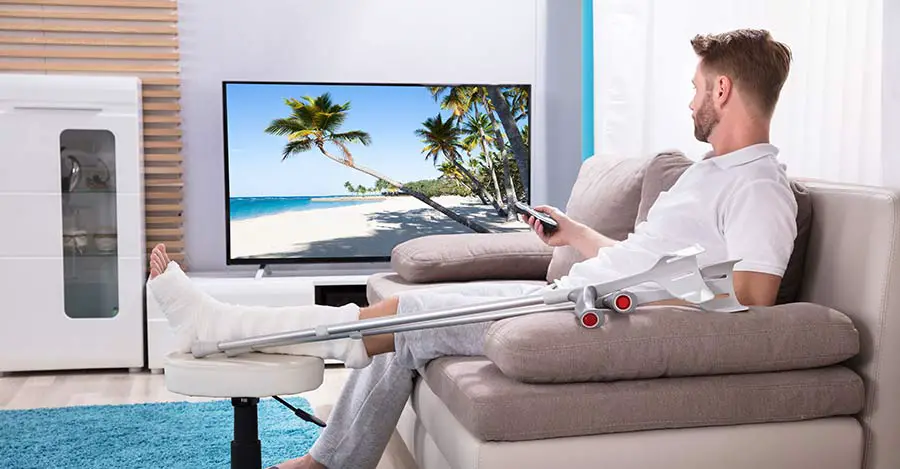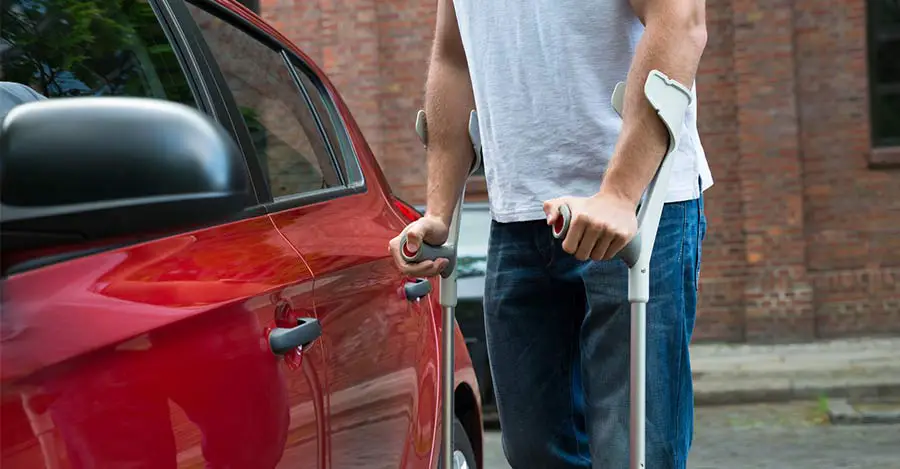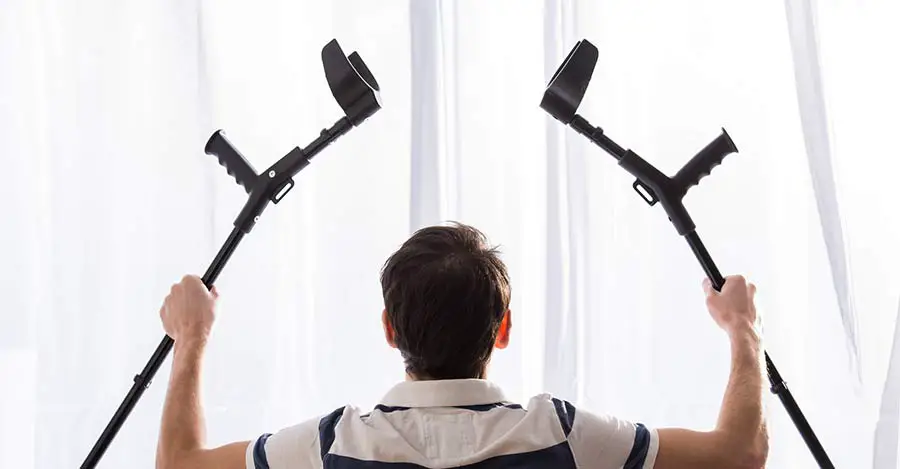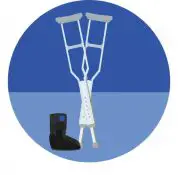Crutches Vs. Scooters
According to statistics, it’s believed that more than 6.8 million Americans use mobility aids to help them walk and maneuver. Of this 6.8 million, it’s estimated that 1.7 million use wheelchairs.
Additionally, 6.1 million use other mobility devices like crutches, canes, walkers, and knee scooters.
Yet between crutches vs. scooters, which is better? If you have mobility issues or have recently been hurt, you’re likely to consider if you should use them. It can be challenging to decide between these devices. We think you may need both. Choose mobility equipment according to your daily activities, it will greatly improve the convenience in your life.
Today we will compare crutches and knee scooters. Let’s take a look at everything you need to know about crutches and scooters to decide which is best suited to you.
A Comparison Of Crutches Vs. Scooters By Looking At 9 Different Aspects
Below we have briefly compared crutches and scooters. We have compared both so that you can make a wisw decision about which type of mobility aid is ideal for you.
1.Weight Restrictions

Often crutches are designed and made to have a weight restriction limit. That’s why when you look at purchasing crutches, you have to check the weight capacity. Most crutches have a weight range of between 100 pounds and 300 pounds.
Unlike crutches, knee scooters are usually more accommodating. They are designed to work for people of low and high weights. Since most knee scooters are more stable and have a more sturdy design, they tend to hold more weight easier. Most knee scooters have a weight limit range of between 160 and 500 pounds.
2.Body Strength

When deciding between crutches and a knee scooter, you need to consider your body strength. If you don’t have a lot of upper body strength and want to use traditional crutches, you’re going to struggle. Should you be fit and able to easily lift your body weight, crutches could be ideal.
Those who have upper-body limitations should consider using a knee scooter. With this mobility device, you don’t need to worry about lifting yourself or potentially injuring yourself. A Knee scooter will distribute your weight. It will also allow you to maneuver your body without much hassle.
Yet, you need to note that whether you can use a knee scooter or crutches depends on your injury or disability. That’s why you should speak to a healthcare professional before making a decision.
3.Price
Crutches tend to cost less than knee scooters. This is because they require fewer materials to function. Unlike knee scooters, crutches don’t need a seat. They also don’t need wheels and other key components that knee scooters need to operate.
On average, adult crutches with a maximum weight limit of 300 pounds cost between $50 and $150. In contrast, the average price for an adult knee scooter with the same weight limit costs between $120 and $280.
4.Weather Resistance

Often many people forget to consider if their mobility aid is suitable for inclement weather conditions. If you live somewhere that experiences challenging weather conditions, you might not want to use crutches. Most crutches cannot be utilized on certain terrains.
When used on hazardous terrains, further injuries can occur. But you can use some replacement (ice) tips in inclement weather.
Scooters are more weather resistant than crutches. That’s why they are better for bad weather conditions. Most knee scooters function on various terrains and in varying climates. This means that knee scooters offer a lower chance of slips and falls in many instances.
Note: Be more careful when using equipment in bad weather to prevent slips and falls.
5.Long Term Utility

Unfortunately, many people have to use a mobility device for months or their entire life. If you don’t have enough upper body strength to use crutches, you’re better off using a knee scooter.
And knee scooter can better ease your pain. Ultimately it will depend on your view and your doctor’s advice which you prefer. Is there enough space in your bathroom to allow you to use the knee scooter? As we know knee scooters need a wide turning radius
It will be more convenient for you on stairs and to move easy for short distances. When you do not use them, you can store them easily.
6.Everyday Applications

When choosing between crutches and a scooter, you need to remember your everyday activities. If you’re a busy person who often travels for work or social outings, you might want to consider a knee scooter.
Using crutches would make it difficult for you to get to everything you want to do. Yet, if you are not busy during the day and don’t need to move around much, you might find crutches more convenient.
If you are getting in and out of the car alone, are you able to put mobility devices in and out of the car by yourself? Maybe crutches will be good choice for you in this situation.
7.Comfort And Convenience
Do you have lifelong mobility issues or need to use a mobility device for a short-term or long-term? If so, you need to consider comfort and convenience. That’s why when debating these aids, you need to determine which will be the most comfortable to use and the most convenient.
For example, a knee scooter will allow you to rest when completing activities. You also won’t need to have impressive upper body strength.
A knee scooter require a relatively large radius of movement. Think about whether your bathroom is large enough to use a knee scooter.
Crutches can also be comfortable. Yet they are better suited for short periods of walking. Crutches, unlike knee scooters, often need more energy and effort. Yet, they are better suited for stairs and steep inclines or declines.
8.Safety
You should take your safety seriously. When using a knee scooter, you can rest your leg on the padded knee rest. You won’t have to hold it above the ground while trying to balance, thus preventing injury.
With a knee scooter, you have more control over how you maneuver. You don’t need to strain yourself when getting from one place to another. This makes you less likely to slip and fall or knock into things and injure or re-injure yourself.
Whether you choose knee scooters or crutches, you’ll need to learn how to use them correctly.
9.Is it A Burden On The Body?
Another important question to answer when debating between crutches and knee scooters is if these devices will be a burden on your body. One of the very best ways to determine if crutches or a knee scooter is best suited to you is to find out which one is easier to use.
Most people prefer a knee scooter because it is easy to maneuver from one place to the next. But long-term use of knee scooters will have knee pain and the risk of accidentally falling off the leg. The use of a knee scooter for over eight hours may have resulted in a deep vein thrombosis (DVT).
Unfortunately, crutches can easily sap energy and strain other muscle groups. Incorrect crutch use can be injury or discomfort.
When To Use Crutches And When Not To

If you have injured your lower body or are dealing with mobility issues, your doctor has likely recommended you use crutches. When should you use crutches, and when shouldn’t you use this mobility device? Have a look below at our brief list of when and when not to use crutches.
When You Should Use Crutches
- When you require a short-term mobility aid.
- When you have injured your foot, ankle, or leg and have to keep weight off of it.
- When your foot or leg is in a cast after surgery.
- When you need a mobility aid to help you with balance issues.
- When you have sufficient upper body strength.
When You Shouldn't Use Crutches
- You should not use crutches directly after a lower-body limb surgery.
- You should not use crutches if you don’t have enough upper body strength.
- You should avoid using crutches if you have a long-term disability.
- You shouldn’t use crutches if you’re an older adult.
- You should avoid crutches if you don’t have the endurance to use them.
When To Use A Scooter And When Not To
Knee scooters might not be as popular as crutches. Yet, they have become one of the go-to mobility aids for those who are injured or who have a disability.
Have a quick look below to learn more about when and when not to use this mobility device.
When You Should Use A Knee Scooter
- You should use a knee scooter if you have a long-term injury or certain types of lower body disabilities.
- When you want to easily maneuver from place to place.
- If you lead a busy life with lots of activity.
- When you have had a leg or foot surgery or amputation.
- If you’re elderly and don’t have the upper body strength for crutches.
When You Shouldn't Use A Knee Scooter
- If you don’t have a moderate to high budget for a mobility aid.
- You shouldn’t use one if it does not have breaks.
- You shouldn’t use a knee scooter if it does not match your weight.
Final Words
Sometimes using a knee scooter is preferable to crutches. This is especially true if you live in an area that experiences bad weather. Using a knee scooter is easier and often far more comfortable. It’s also often better for those who don’t have the upper body strength to use crutches.
Yet, knee scooters are more expensive than crutches and might not be as easily maneuverable in certain situations. When getting in and out of cars and stairs alone, you may wish you had crutches. Your bathroom may not have enough space for you to use a knee scooter
Ultimately if you want to choose one from crutches or a knee scooter, it depends on your personal preferences, budget, and your daily activities of daily needs.
In my opinion, having both crutches and a knee walker will make your daily activities easier.

